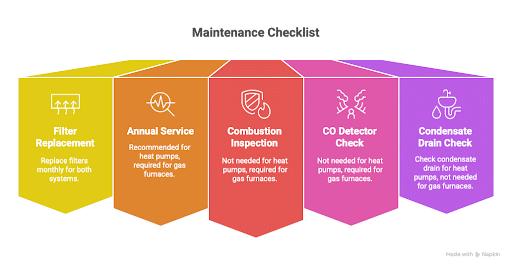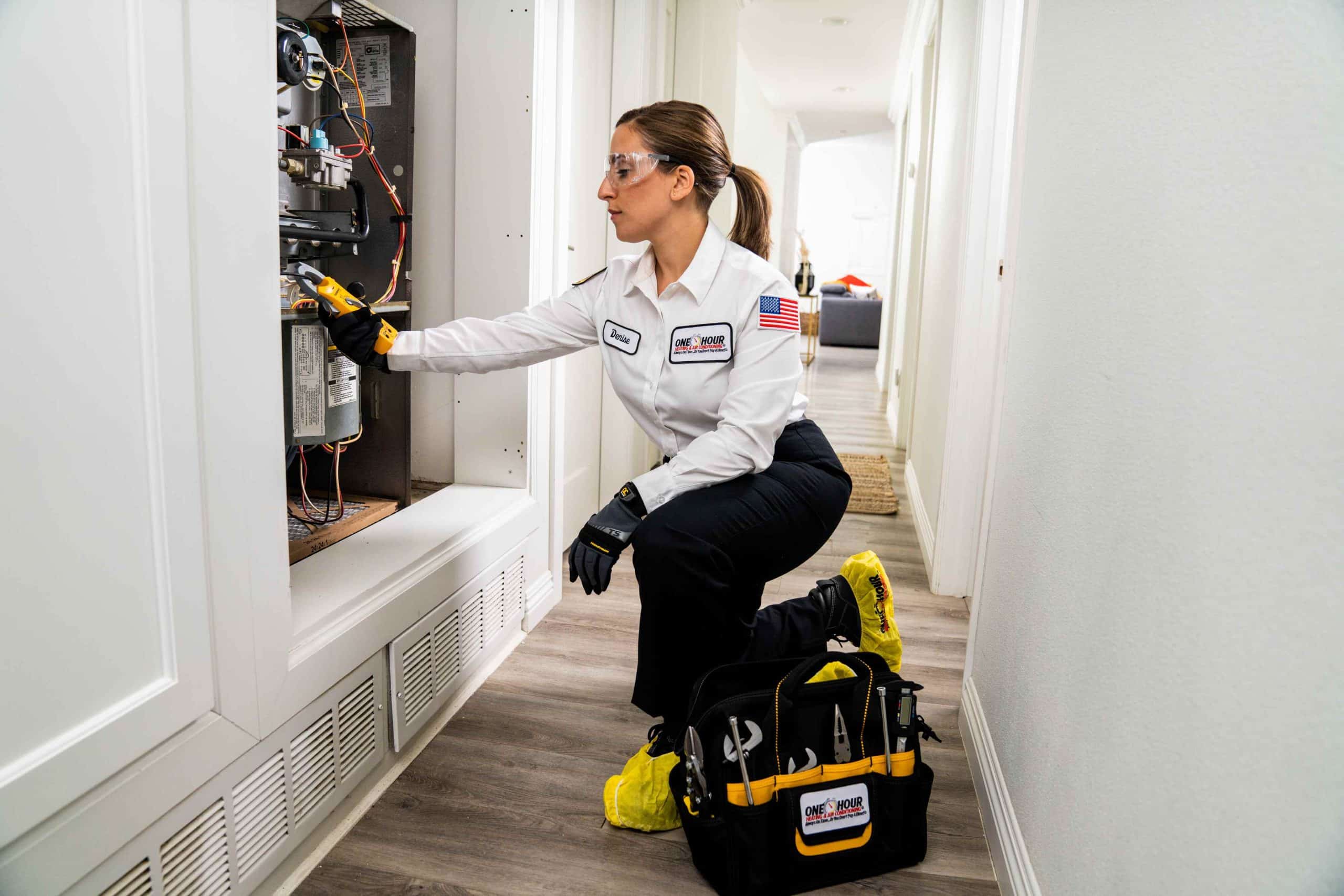October 1, 2025
Category: General,
Most homeowners don’t give much thought to their heating system until something goes wrong. Maybe the furnace stops working, the bills keep climbing, or the house just doesn’t stay warm enough in the winter. When that happens, the question of what to replace it with suddenly becomes urgent.
For decades, the comparison was simple: electric furnace vs gas furnace. But that’s no longer the reality in most homes. Today, electric furnaces are rarely installed as the primary heat source. Instead, they are almost always paired with a heat pump, providing auxiliary or backup heat when outdoor temperatures get too cold for the heat pump to run efficiently.
That means the real decision for homeowners isn’t gas vs electric furnace. It’s whether a heat pump with electric backup or a gas furnace makes more sense for your situation. Both options work, but the right choice depends on where you live, what your utility rates look like, and your priorities around comfort, safety, and long-term costs.
How Do Gas Furnaces and Heat Pumps Work?
Understanding the basics of how each system works makes it easier to see which one fits your home best.
Gas Furnace: Combustion-Based Heating
A gas furnace generates heat by burning natural gas in a sealed combustion chamber. The heat exchanger warms air as it passes through, and a blower fan circulates that warm air through your ducts. Because combustion creates exhaust gases, venting is required to safely move them outside.
This process produces powerful, steady heat, which is why gas furnaces remain popular in northern states with long, harsh winters. When the temperature plunges, you can count on a gas furnace to heat your home quickly and effectively.
Heat Pump + Electric Backup: Two-in-One Comfort
A heat pump works very differently. Instead of creating heat by burning fuel, it transfers heat from one place to another. In the winter, it extracts heat from the outdoor air and moves it inside. In the summer, it reverses direction and works like an air conditioner, cooling your home by moving heat outside.
When outdoor temperatures drop too low for the heat pump to operate efficiently, the system automatically switches on electric resistance heating strips (sometimes referred to as an electric furnace). These strips act as a backup to ensure your home stays comfortable even during cold snaps.
For homeowners in moderate climates, this combination provides year-round comfort with one system for both heating and cooling, with backup heat only when needed.
Upfront vs Long-Term Costs
When deciding on a system, cost is often top of mind. Both systems differ in where you’ll pay more.
Heat Pump with Electric Backup
- Installation: Simpler to install since no gas line or venting is required
- Upfront cost: Usually lower than a gas furnace retrofit
- Operating cost: Varies by local electricity rates. Bills can rise in colder climates where the electric backup runs more frequently
Gas Furnace
- Installation: Requires gas hookups, venting, and code compliance, which increases installation complexity
- Upfront cost: Higher than a heat pump system in most cases
- Operating cost: Often lower in colder climates where natural gas is affordable and heating demand is high
Bottom line: Heat pumps are attractive for lower installation costs and year-round utility. Gas furnaces typically save more over time in colder regions with heavy heating needs.
Energy Efficiency and Performance
Both options are efficient, but their strengths depend on your climate.
Want a deeper look at real-world efficiency? This guide breaks down how heat pumps stack up against furnaces and traditional AC systems.
Heat Pump with Electric Backup
- Efficiency: Among the most efficient heating technologies available
- Performance: Delivers two to three times more heat energy than the electricity it consumes
- Backup heat: Electric strips ensure comfort but consume more energy when active
Gas Furnace
- Efficiency rating: High-efficiency models can reach up to 98 percent AFUE
- Performance: Provides steady, reliable heat output regardless of how cold it is outside
- Cold climate strength: Maintains efficiency and comfort even in extreme winters
Key takeaway: Heat pumps lead in mild climates with higher efficiency. Gas furnaces hold the advantage in long, cold winters where consistent, powerful heat is needed.
Safety Considerations
Safety is another factor homeowners must weigh.
Gas Furnace
- Risks: Potential for carbon monoxide leaks, gas leaks, or combustion hazards if not properly maintained
- Requirements: Annual inspections, CO detectors, and clear venting are essential
- Reliability: Safe when maintained, but more upkeep is necessary
Heat Pump with Electric Backup
- Risks: No combustion, so no carbon monoxide concerns
- Requirements: Electrical system checks and regular filter maintenance
- Reliability: Lower overall safety risk, especially for households with children, seniors, or sensitive air quality needs
Key takeaway: Heat pumps are the safer option from an emissions perspective, while gas furnaces require vigilant maintenance to ensure safe operation.
Climate Considerations
Your location plays one of the biggest roles in which system makes sense.
Cold Climates (Northern U.S.)
- Gas furnaces heat faster and deliver stronger output. But if your furnace starts acting up, especially in the dead of winter, these common noises could signal a problem.
- Operating costs are lower where natural gas is inexpensive
- Best suited for households needing heat through long, freezing winters
Mild or Warm Climates (Southern U.S.)
- Heat pumps handle moderate heating needs efficiently
- Backup heat strips only run during short cold spells
- Best suited for regions with shorter, less intense winters
Key takeaway: If winters are long and harsh, gas is often the smarter choice. If winters are short and moderate, heat pumps with backup heat provide reliable comfort with better efficiency.
Environmental Impact
Environmental impact is becoming a priority for many homeowners.
Heat Pump with Electric Backup
- Emissions: No in-home emissions during operation
- Grid impact: Environmental footprint depends on how your electricity is generated
- Green potential: Nearly carbon-neutral if powered by renewable energy sources like wind or solar
Gas Furnace
- Emissions: Burns fossil fuels directly in your home, releasing CO₂ and nitrogen dioxide
- Efficiency: Can still be practical where electricity comes primarily from coal, since gas may result in fewer total emissions in such grids
Key takeaway: Heat pumps are the cleaner option when electricity comes from renewable or low-carbon sources. Gas furnaces carry more emissions but can be relatively better in regions with coal-heavy electric grids.
| Feature | Heat Pump + Electric Backup | Gas Furnace |
| Upfront Cost | Lower, fewer installation needs | Higher, requires gas line and venting |
| Monthly Cost | Can rise in colder climates | Often lower in high-demand areas |
| Efficiency | Excellent in mild climates | High, even in extreme cold |
| Heating Strength | Moderate, backup needed in cold | Strong, fast heat output |
| Safety Risk | Low (no combustion) | Medium (CO risk if not maintained) |
| Climate Fit | Mild to Warm | Cold |
| Environmental Impact | Cleaner with renewable electricity | Fossil fuel emissions |

Final Thoughts: How to Choose
There is no single winner in the heat pump vs gas furnace debate. The best choice depends on balancing your climate, utility rates, existing home setup, and your personal priorities.
Choose a Heat Pump with Electric Backup If:
- You live in a moderate or warm climate
- You want a single system that provides both heating and cooling
- You prioritize safety, air quality, and quieter operation
Choose a Gas Furnace If:
- You live in a region with long, cold winters
- You already have natural gas service in your home
- You want strong, reliable heating with lower monthly bills
Why Work With One Hour Heating & Air Conditioning
If you’re still unsure, you don’t have to make the decision alone.
At One Hour Heating & Air Conditioning, our comfort advisors walk you through the options based on your home, your budget, and your long-term goals. We’ll help you weigh the pros and cons of gas furnaces, heat pumps, and electric backup systems so you can feel confident you’re choosing the right solution.
And when it’s time to install, you’ll get the peace of mind of our on-time guarantee. If we don’t show up on time, your HVAC repair is free. From next-day installations to our System Precision Tune-Up that goes far beyond the basics, we’re here to keep your home comfortable with reliable, professional service.
Call us today to schedule your consultation and let us help you find the perfect heating system for your home.
Frequently Asked Questions
Is it cheaper to heat a house with gas or electricity?
In colder regions, natural gas usually costs less than electricity for heating. In milder climates, a heat pump system can be cost-effective because it runs efficiently most of the season, with electric backup kicking in only during cold snaps.
Do people still install electric furnaces on their own?
It’s uncommon. Electric furnaces today are usually paired with heat pumps as backup heat. A standalone electric furnace typically isn’t recommended unless the climate is very mild and gas is not available.
Are heat pump systems safer than gas furnaces?
Yes. With no combustion, there’s no carbon monoxide risk. Gas furnaces can be very safe too, but they require annual inspections, proper venting, and working CO detectors.
Do heat pumps work well in cold climates?
Modern heat pumps can operate in colder temperatures, but efficiency drops as the temperature falls. That’s why they rely on electric backup strips, and why many homeowners in very cold regions still prefer a gas furnace.
Which is more environmentally friendly?
Heat pumps are cleaner inside the home and can be very green if powered by renewable electricity. Gas furnaces burn fossil fuels directly, so they carry a higher emissions footprint. However, in areas with coal-heavy electricity grids, gas may result in fewer total emissions.

